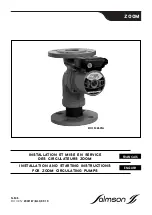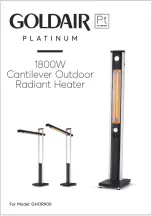
13 / EN
TPRV & PRV DISCHARGE
The discharge from the cylinder TPRV and combination PRV must
be plumbed to the tundish and should not be used for any other
purpose. The tundish must be vertical and fitted within 750mm of the
pressure relief valve and must be located with the Nuos. The tundish
must be in a position visible to the occupants, and positioned away
from any electrical devices. The discharge pipe from the tundish
should terminate in a safe place where there is no risk to persons in
the vicinity of the discharge, and be made of a suitable material in line
with Building Regulation G3 (preferably metal). The tundish must not
be located near or above electrical components, switches or junction
boxes.
TPRV & PRV DISCHARGE PIPES – TO GULLY
The discharge pipes from safety devices (tundish) must be installed
to fully comply with Part G3 of the Building Regulations (latest edition).
The following text, and diagram 1 are reproduced from G3 Building
Regulations 2010 (as amended) Draft.
BUILDING REGULATIONS G3
(The following text is reproduced from the Building Regulations. It is
included here for reference only).
These are a statutory document and take priority over all other reg-
ulations and recommendations. The installation of an unvented hot
water system of over 15 litres is classified as a “Controlled Service”
and Regulation G3 applies. To meet the requirements of the regula-
tion, installation of an unvented system should be undertaken by a
“competent installer”. All installations of unvented hot water storage
systems having a capacity of more than 15 litres should be notified
to the relevant Local Authority by means of building notice 10 or by
the submission of full plans. It is important to note that it is a criminal
offence to install an unvented hot water storage system over 15 litres
without notifying the Local Authority
DISCHARGE PIPES FROM SAFETY DEVICES
Discharge pipe D1
1. Safety devices such as temperature relief valves or combined
temperature and pressure relief valves should discharge either
directly or by way of a manifold via a short length of metal pipe (D1)
to a tundish.
2. The diameter of discharge pipe (D1) should be not less than the
nominal outlet size of the safety device, e.g. temperature relief
valve.
3. Where a manifold is used it should be sized to accept and dis-
charge the total discharge from the discharge pipes connected to it.
4. Where valves other than a temperature and pressure relief valve
from a single unvented hot water system discharge by way of the
same manifold that is used by the safety devices, the manifold
should be factory fitted as part of the hot water storage system
unit or package.
5. The tundish should be vertical, located in the same space as
the unvented hot water storage system and be fitted as close as
possible to, and lower than, the safety device,with no more than
600mm of pipe between the valve outlet and the tundish (see
Diagram 1).
Note: To comply with the Water Supply (Water Fittings) Regula-
tions, the tundish should incorporate a suitable air gap.
6. Any discharge should be visible at the tundish. In addition, where
discharges from safety devices may not be apparent, e.g. in dwell-
ings occupied by people with impaired vision or mobility, consid-
eration should be given to the installation of a suitable safety
device to warn when discharge takes place,e.g. electronically op-
erated.
Discharge pipe D2
7. The discharge pipe (D2) from the tundish should: a. have a vertical
section of pipe at least 300mm long below the tundish before
any elbows or bends in the pipework (see Diagram 1); and b. be
installed with a continuous fall of at least 1 in 200 thereafter.
8. The discharge pipe (D2) should bemade of: a. metal; orb. oth-
er material that has been demonstrated to be capable of safely
withstanding temperatures of the water discharged and is clearly
and permanently marked to identify the product and performance
standard (e.g. as specified in the relevant part of BS 7291-1:2006
Thermostatic pipes and fittings for hot and cold water for domestic
purposes and heating installations in buildings General require-
ments).
9. The discharge pipe D2 should be at least one pipe size larger
than the nominal outlet size of the safety device unless its total
equivalent hydraulic resistance exceeds that of a straight pipe 9m
long, i.e. for discharge pipes between 9m and 18m the equiva-
lent resistance length should be at least two sizes larger than the
nominal outlet size of the safety device; between 18 and 27m at
least 3 sizes larger, and so on; bends must be taken into account
in calculating the flow resistance. See Diagram 1, Table 3.1 and the
worked example.
Note: An alternative approach for sizing discharge pipes would
be to follow Annex D, section D.2 of BS 6700:2006 + A1:2009
Specification for design, installation, testing and maintenance of
services supplying water for domestic use within buildings and
their curtilages.
250I WITH TYPICAL BOILER CONNCETION
Содержание 200D
Страница 1: ...IT HEAT PUMP WATER HEATER Instructions for installation use maintenance 200D 250I ...
Страница 26: ...26 EN 32 8 BENChMARK COMMISSIONING ChECKLIST ...
Страница 27: ...27 EN 33 9 BENChMARK SERVICE RECORd ...
Страница 29: ...29 EN ...
Страница 30: ...30 EN ...
Страница 31: ...31 EN ...














































